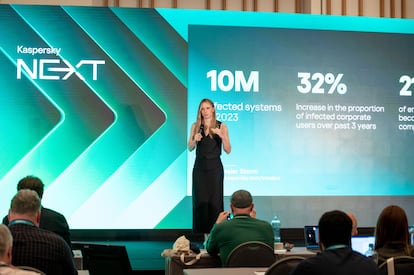Most passwords are cracked in less than an hour, and many in just one minute
The dark web and Telegram channels offer ‘all-inclusive’ packages for around $80 per week to decrypt access to accounts

“Humans are very vulnerable.” That’s according to Yuliya Novikova, head of Fingerprint Intelligence at the cybersecurity company Kaspersky. She made the comment after an exhaustive study of 193 million passwords found that only two out of 10 are secure. Most are cracked in an hour, and many of them in just a minute. And cracking them costs very little. Dark web and Telegram channels — where cybercrime weapons are sold — offer “all-inclusive” packages for just €80 ($85) a week. These packages include programs, cloud servers and the data of potential victims.
“Our data is like our home. Would you leave it open for anyone to enter?” asks Lilian Balatsou, an expert in artificial intelligence linguistics and a doctor in Cognitive Neuroscience from Bangor University, during a meeting of the cybersecurity firm in Athens. After the Kaspersky’s study, it would appear that we do: according to the research, we leave the door open half of the time.
Novikova explains that 40% of cyberattacks (a third of which are followed by kidnapping and extortion) begin with a compromised account. In this way, these holders of house keys misuse them and leave the locks unlocked or allow them to be copied, more than once in 21% of cases. “Human error is the main cause of incidents,” warns Novikova, who points out that 10 million systems were infected last year, 32% more than at the beginning of the decade.
According to Kaspersky data, 45% of passwords are compromised in less than a minute, 14% in less than an hour and another 14% after more than a day or less than a month. In other words, only a little more than two out of every 10 access keys to critical systems are secure.
The rest use names, common words or dictionary terms that, even if altered by numbers or signs that replace letters, are easily vulnerable. What’s more, hackers aren’t wasting their time trying to decrypt passwords. “Cybercriminals are very creative, but also lazy,” says Novikova, pointing out that the cyberattack weapons sales channels offer — for €80 ($85) a week — subscription packages that include not only the databases of vulnerable victims, but also the programs and servers to run them without the hacker’s own infrastructure. These systems are capable of violating even multifactor authentication protocols, which only allow user access, when they provide two or more different proofs of identity.
Solutions
Marco Preuss, deputy director of the Global Research and Analysis Team (GReAT) and head of the Kaspersky Europe Research Center, is even wary of biometric identification systems, which he believes also involve the use of personal information.
The experts who participated in the meeting in Athens support instead the use of password managers, programs that can safely store unique users and access codes and even generate strong ones for each use.
Other effective tactics include: using a different password for each service so that, in the event of theft, only one account is compromised, using unusual words or mixing them up, checking the strength of your password using online services, avoiding passwords that contain personal data that hackers may have access to (such as personal names and dates that are accessible through social media) and enabling two-factor authentication (2FA).
Rafael Conde del Pozo, director of innovation at Softtek, point to one other risk factor: cell phones. As he explains, “mobile devices have become extensions of ourselves and require comprehensive protection against emerging vulnerabilities.”
For this reason, he suggests activating advanced biometric authentication systems, popularly used in cell phone payments; behavioral biometrics, which analyze patterns that do not match the user; and artificial intelligence authentication systems, which identify anomalies, encrypt data and restrict access.
Regarding cell phone vulnerabilities, Check Point’s Threat Intelligence division has identified multiple campaigns that take advantage of Rafel RAT, an open source tool for Android devices that was developed for phishing campaigns via messages and conversations that trick users into installing malicious applications hidden under a false name and icon. These apps request extensive permissions, display legitimate web pages or imitate them, and then secretly crawl the device to leak data.
Security measures involve all types of programs, including social media applications. Check Point, after detecting illegal access through direct messages on TikTok, recommends setting strong passwords, setting up two-factor authentication through the network’s security page to enable the “sign in with verification” feature, and reporting any unusual activity. A TikTok vulnerability recently affected media and celebrity accounts.
Sign up for our weekly newsletter to get more English-language news coverage from EL PAÍS USA Edition
Tu suscripción se está usando en otro dispositivo
¿Quieres añadir otro usuario a tu suscripción?
Si continúas leyendo en este dispositivo, no se podrá leer en el otro.
FlechaTu suscripción se está usando en otro dispositivo y solo puedes acceder a EL PAÍS desde un dispositivo a la vez.
Si quieres compartir tu cuenta, cambia tu suscripción a la modalidad Premium, así podrás añadir otro usuario. Cada uno accederá con su propia cuenta de email, lo que os permitirá personalizar vuestra experiencia en EL PAÍS.
¿Tienes una suscripción de empresa? Accede aquí para contratar más cuentas.
En el caso de no saber quién está usando tu cuenta, te recomendamos cambiar tu contraseña aquí.
Si decides continuar compartiendo tu cuenta, este mensaje se mostrará en tu dispositivo y en el de la otra persona que está usando tu cuenta de forma indefinida, afectando a tu experiencia de lectura. Puedes consultar aquí los términos y condiciones de la suscripción digital.
More information
Archived In
Últimas noticias
Mustafa Suleyman: ‘Controlling AI is the challenge of our time’
Venezuela breaks energy agreements with Trinidad and Tobago due to alleged complicity with the US
The murder of Michele and Rob Reiner: A tale of horrific days in Hollywood
Trump orders a ‘complete blockade of sanctioned oil tankers’ going to and from Venezuela
Most viewed
- ‘El Limones’ and the growing union disguise of Mexican organized crime
- Christian Louboutin: ‘Young people don’t want to be like their parents. And if their parents wear sneakers, they’re going to look for something else’
- ‘We are dying’: Cuba sinks into a health crisis amid medicine shortages and misdiagnosis
- A mountaineer, accused of manslaughter for the death of his partner during a climb: He silenced his phone and refused a helicopter rescue
- The low-cost creative revolution: How technology is making art accessible to everyone











































